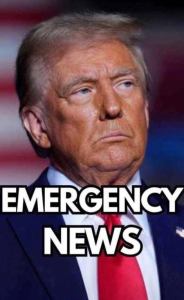When a sitting U.S. president signs an executive order, it can reshape the country’s political landscape—especially when the issue involves how elections are run. That’s exactly what happened when Donald Trump signed a new executive order that many say could change the way future elections in the United States are conducted. While the full impact of the order will unfold over time, the immediate reaction has been intense, drawing both praise and criticism from across the political spectrum.
What the Executive Order Is About
The executive order focuses on election procedures, voter identification, mail-in ballots, and election security. According to the announcement, the order’s main goal is to “strengthen the integrity of the election process” and ensure that “every legal vote is counted and every illegal vote is prevented.”
One of the most notable elements is the introduction of stricter voter ID requirements at the federal level. While many states already have their own voter ID laws, this order pushes for a uniform standard nationwide. It also lays out steps to verify citizenship and identity more rigorously.
Another major component is related to mail-in and absentee voting, which expanded significantly during the pandemic. The order directs election officials to implement more tracking systems, signature verification technology, and standardized deadlines. These measures are intended to reduce delays in counting ballots and prevent fraudulent activity.
Increased Federal Oversight of Elections
Although the U.S. Constitution gives states the authority to run elections, the executive order directs federal agencies to monitor and support states in ensuring compliance with the new standards. This means the Department of Justice, the Department of Homeland Security, and other agencies will play a more active role in election security.
Supporters argue that this will create more consistent rules across the country. Critics, however, see it as an overreach of federal power into state-controlled elections. Legal challenges are expected, and court battles could shape how much of this order actually takes effect.
A Response to Ongoing Election Debates
For years, American elections have been a topic of heated debate—especially issues around voter fraud, mail-in voting, and the security of voting machines. This executive order is widely viewed as a response to concerns raised in previous election cycles, including controversies surrounding voter rolls and ballot handling.
Trump’s supporters say this is a long-awaited measure to make sure elections are fair and transparent. His opponents, however, argue that it could make it harder for some citizens to vote, especially in communities where access to identification or transportation is limited.
How It Could Affect Voters
If fully implemented, the order could bring several changes for ordinary voters:
-
New ID Requirements: Voters may need to provide more documentation than in previous elections.
-
Fewer Mail-in Ballots Without Verification: States will be required to match signatures and use more secure systems for absentee voting.
-
Potential Shorter Deadlines: Ballots received after Election Day could face stricter cutoffs, limiting late counting.
-
More Election Monitors: Federal observers may be present in more polling stations across the country.
While these measures may reassure some voters about security, they could also discourage participation if the process becomes too complicated or restrictive.
Reactions From Political Leaders
The reaction in Washington was swift. Republican lawmakers and officials largely praised the move, calling it “a strong step toward restoring confidence in elections.” They argue that confidence in the process is just as important as the outcome itself.
Democratic leaders sharply criticized the order, calling it a potential threat to voting rights. They argue that imposing uniform federal standards undermines state autonomy and could suppress voter turnout, particularly among minority and low-income communities.
Civil rights organizations also expressed concern. Groups that advocate for voting access said they were prepared to challenge the order in court if it creates unnecessary barriers to voting.
Legal and Constitutional Challenges Ahead
Because elections are largely managed at the state level, legal experts anticipate a wave of lawsuits. Some states may argue that the executive order infringes on their constitutional rights. Others may support it, hoping to align their systems with federal standards.
The courts could ultimately decide how much of the order will be enforceable. This means the full impact may not be felt immediately but rather in future election cycles, depending on how legal battles play out.
Potential Long-Term Effects on Elections
If the executive order remains in place after legal scrutiny, the U.S. electoral landscape could look very different in the coming years:
-
More Uniform Election Rules: Fewer differences between states in how elections are conducted.
-
Faster Results: Improved ballot tracking could lead to quicker vote counts.
-
Stronger ID Standards: Voters nationwide would follow similar verification processes.
-
Increased Security Measures: Greater federal monitoring could deter fraud but raise concerns about privacy.
These changes would affect everything from local school board elections to presidential contests, reshaping how campaigns strategize and how voters engage with the process.
Public Opinion: A Divided Nation
Polls and public sentiment reveal a deep divide on election security issues. Some Americans feel stricter rules are necessary to prevent fraud and restore trust. Others believe such measures are solutions to a problem that’s statistically rare and fear they could silence legitimate voices.
Town hall meetings, rallies, and online forums have already become battlegrounds for these discussions. For many citizens, this isn’t just a policy issue—it’s about the future of democracy itself.
What Happens Next
The executive order will take effect in stages. Federal agencies are expected to issue guidance to states, while Congress may attempt to pass legislation either supporting or countering the order. Lawsuits could delay implementation, but election officials are already preparing for possible changes ahead of upcoming federal and state contests.
Observers note that executive orders can be modified or reversed by future administrations, meaning the ultimate impact may depend on political shifts in Washington. However, even temporary changes could influence how campaigns are run and how voters experience elections.
Final Thoughts
The executive order signed by Donald Trump marks a significant moment in U.S. election history. It reflects ongoing tensions between security and accessibility, between federal power and state autonomy, and between competing visions of how democracy should function.
Whether one views it as a protective measure or a restrictive barrier, there’s no denying its potential to shape how Americans vote in the years to come. The coming months will reveal whether it stands as a lasting reform or becomes another chapter in the nation’s ongoing election debates.
In the end, one thing is certain: the way Americans choose their leaders is about to face a new test—and the world will be watching closely.



